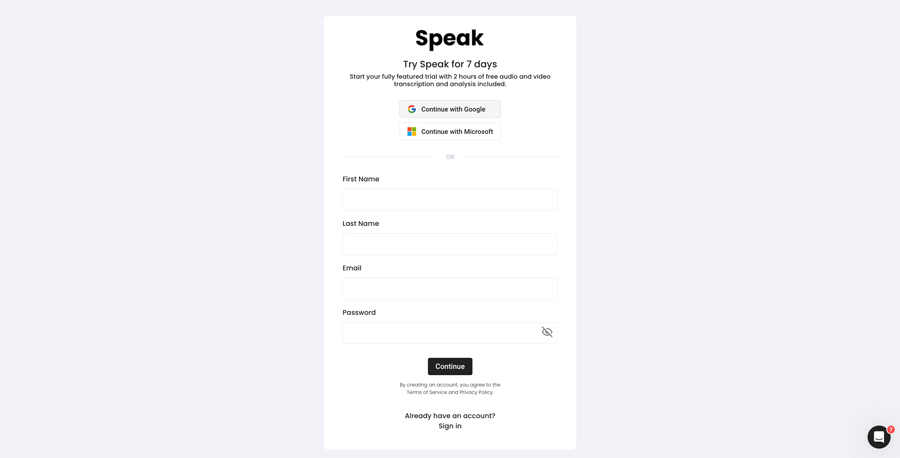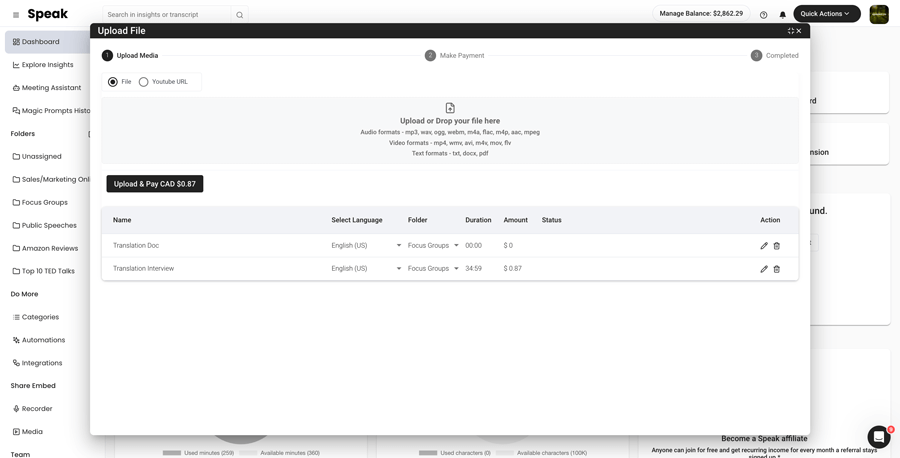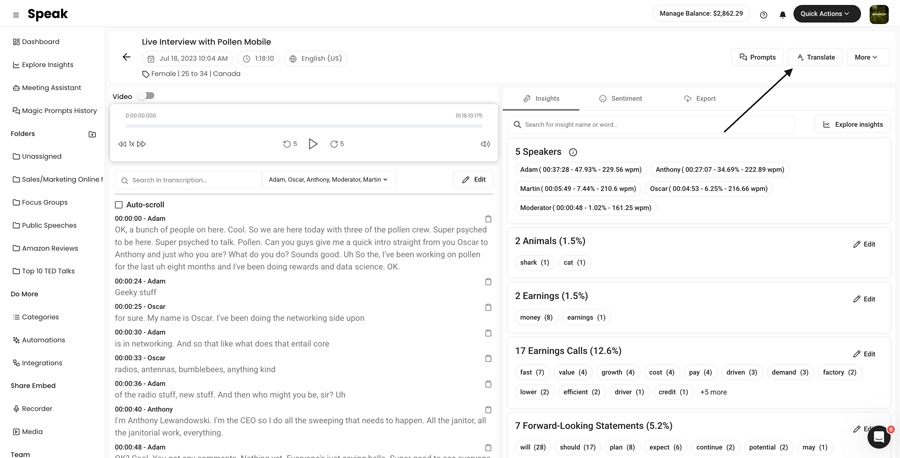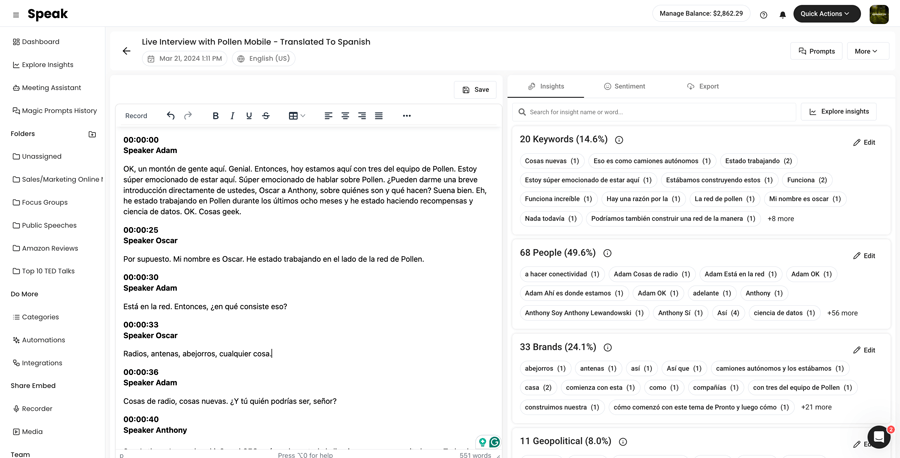How To Translate Chinese (Simplified) to Korean
Translating Chinese (Simplified) to Korean is super simple!

Step 1: Register for Speak
Register for Speak using this link.
Once you register, you can instantly begin translating your Chinese (Simplified) to Korean file(s).

Step 2: Upload Your Chinese (Simplified) file(s)
As soon as you log in, you will be redirected to the dashboard.
Once there, you can select the Quick Action “New Upload”.
In Speak, you can seamlessly upload, transcribe and translate audio, video and text files all at once!

Step 3: Translate Your Chinese (Simplified) file(s) to Korean
Once the file is uploaded, simply visit your file and select “Translate”.
If it is an audio and video file, Speak will ask you if you want to keep the speaker names and timestamps in the translation.
Want to translate many files at once? No problem!
You can view the files you want to automatically translate from Chinese (Simplified) to Korean from the folder level and instantly translate as many files as you need with our artificial intelligence translation in just a few clicks.

Step 4: That’s It! View, Analyze, Modify & Export Your New Korean file(s)
Once the translation is done, you will be alerted and you will see a new document in the same folder your original file is in.
The file will be named the same but with a dash indicating that it is the translated version.
Need support with your Chinese (Simplified) translation?
We are always here and happy to help at Speak!
Just send us a message on live chat on the bottom right corner and we will ensure you are set up for success.
Interested in translating Chinese (Simplified) or other languages to different languages? View our entire list of supported translation languages here.
Automatic, accurate, instant AI translation from Chinese (Simplified) to Korean is here for you.
Register for Speak using this link and begin translating Chinese (Simplified) to Korean today.
Unlocking the Potential of AI Translation: From Chinese (Simplified) to Korean
In an increasingly globalized world, the need for fast, accurate translation between languages has never been greater. For businesses and researchers exploring the expansive markets and rich cultures of East Asia, bridging the linguistic divide between Chinese (Simplified) and Korean presents a unique set of opportunities and challenges. Enter the era of AI translation – a transformative technology that is reshaping the landscape of communication, relationship-building, and cross-border collaboration.
The Benefits of AI-Powered Chinese (Simplified) to Korean Translation
Speak AI leverages cutting-edge natural language processing (NLP) and large language models to offer unparalleled Chinese (Simplified) to Korean translation services. Our technology goes beyond mere word-to-word translation, understanding context, nuance, and cultural subtleties. This ensures that every translation is not only accurate but also culturally and linguistically appropriate.
Enhanced Communication and Collaboration
With Speak AI, overcoming language barriers becomes seamless, facilitating smoother communication and collaboration among Chinese and Korean-speaking partners, clients, and colleagues.
Expanded Market Reach
Our AI translation tools enable businesses to easily adapt their products, services, and marketing materials for the Korean market, significantly expanding their reach and potential customer base.
Increased Efficiency and Reduced Costs
Automatically translating documents, audio, and video content eliminates the need for manual translation services, saving both time and money while increasing productivity.
Personalizing Experience with AI Meeting Assistant
Speak AI’s AI Meeting Assistant is another revolutionary tool that supports seamless cross-lingual interactions. Integrated with platforms like Microsoft Teams, Zoom, Google Meet, and Webex, it automatically transcribes and analyzes meetings in real-time, providing instant translations from Chinese (Simplified) to Korean and vice versa. This ensures that every participant, regardless of their language proficiency, stays on the same page.
Real-Time Transcription and Translation
Our AI Meeting Assistant captures and translates conversations as they happen, facilitating real-time understanding and engagement among participants.
Automatic Summarization and Analysis
Post-meeting, the assistant provides summaries and analyses, highlighting key points, action items, and sentiment, all translated into your preferred language.
Exploring the Richness of Chinese (Simplified) and Korean
Global Influence and Popularity
Chinese (Simplified) and Korean are among the most spoken languages in the world, with significant communities not only in China and South Korea but also in regions across the globe. Chinese, with over a billion speakers, has a profound influence on global commerce, culture, and politics. Korean, while spoken by a smaller population, captivates an international audience through its dynamic entertainment industry and technological innovations.
Cultural Enrichment and Connectivity
Translating between these languages is not just a matter of facilitating transactions or information sharing; it’s about weaving together the rich tapestries of their cultures. It opens doors to exploring historical texts, contemporary literature, and groundbreaking research, enriching our understanding of the human experience across geographical boundaries.
Interesting Stats and Fun Facts
– Chinese characters once formed the basis of written Korean, and remnants of this historical connection can still be seen in modern Korean vocabulary and cultural references.
– Korean Hangul is celebrated for its scientific design and efficiency, often cited as one of the most logical writing systems in the world.
– The Chinese Zodiac system, deeply embedded in Chinese culture, also finds resonance in Korean traditions, influencing festivals and celebrations.
Differences and Similarities in Language Structure
While Chinese is a tonal language, reliant on pitch to distinguish between meanings, Korean emphasizes sentence structure and verb conjugations. Despite these differences, both languages share commonalities such as the use of honorifics to convey respect and social hierarchy, reflecting the value both cultures place on social relations and etiquette.
Speak AI: Bridging Cultures, Connecting Worlds
At Speak AI, we are committed to breaking down language barriers, facilitating seamless communication, and opening avenues for cultural and commercial exchange. Our AI-powered translation tools, backed by our 4.9 rating on G2 and a community of over 150K users, are designed to empower researchers and businesses to thrive in a multilingual, multicultural world.
Experience the future of communication with Speak AI’s translation solutions – where technology meets human understanding, enabling you to speak and understand any language, anywhere, at any time.
—
Frequently Asked Questions
What locations are Chinese (Simplified) and Korean popular?
Chinese (Simplified) is predominantly used in mainland China, Singapore, and Malaysia, serving as the official language. It is also widely understood and studied by Chinese communities worldwide. Korean is mainly spoken in South Korea and North Korea, with significant speaker populations in the United States, Canada, and Japan due to the Korean diaspora.
What are some fun facts about Chinese (Simplified) and Korean?
One intriguing fact is that Korean Hanbok and Chinese Hanfu traditional dresses share historical roots, reflecting ancient cultural exchanges. Another fun fact is that both languages use red ink only for correcting papers or writing names of the deceased, highlighting a shared cultural superstition against using red ink for names under other circumstances.
What are the differences and similarities between Chinese (Simplified) and Korean?
While the two languages differ significantly in grammar, phonology, and script, they share historical bonds and cultural exchanges that manifest in loanwords, expressions, and idiomatic phrases. Both cultures also share similar philosophies, such as Confucianism, influencing social norms, customs, and languages.
Translate Chinese (Simplified) To These Other Supported Languages:
- Translate Chinese (Simplified)-to-Albanian
- Translate Chinese (Simplified)-to-Amharic
- Translate Chinese (Simplified)-to-Arabic (Egypt)
- Translate Chinese (Simplified)-to-Arabic (Iraq)
- Translate Chinese (Simplified)-to-Arabic (Israel)
- Translate Chinese (Simplified)-to-Arabic (Jordan)
- Translate Chinese (Simplified)-to-Arabic (Kuwait)
- Translate Chinese (Simplified)-to-Arabic (Lebanon)
- Translate Chinese (Simplified)-to-Arabic (Oman)
- Translate Chinese (Simplified)-to-Arabic (Palestinian Authority)
- Translate Chinese (Simplified)-to-Arabic (Qatar)
- Translate Chinese (Simplified)-to-Arabic (Saudi Arabia)
- Translate Chinese (Simplified)-to-Arabic (Syrian Arab Republic)
- Translate Chinese (Simplified)-to-Arabic (United Arab Emirates)
- Translate Chinese (Simplified)-to-Arabic Modern Standard (Bahrain)
- Translate Chinese (Simplified)-to-Armenian
- Translate Chinese (Simplified)-to-Azerbaijani
- Translate Chinese (Simplified)-to-Bengali
- Translate Chinese (Simplified)-to-Bosnian
- Translate Chinese (Simplified)-to-Bulgarian
- Translate Chinese (Simplified)-to-Catalan
- Translate Chinese (Simplified)-to-Chinese (Cantonese, Traditional)
- Translate Chinese (Simplified)-to-Chinese (Simplified)
- Translate Chinese (Simplified)-to-Chinese (Traditional)
- Translate Chinese (Simplified)-to-Croatian
- Translate Chinese (Simplified)-to-Czech
- Translate Chinese (Simplified)-to-Danish
- Translate Chinese (Simplified)-to-Dari
- Translate Chinese (Simplified)-to-Dutch
- Translate Chinese (Simplified)-to-English
- Translate Chinese (Simplified)-to-English (Australia)
- Translate Chinese (Simplified)-to-English (India)
- Translate Chinese (Simplified)-to-English (Ireland)
- Translate Chinese (Simplified)-to-English (New Zealand)
- Translate Chinese (Simplified)-to-English (Scottish)
- Translate Chinese (Simplified)-to-English (South African)
- Translate Chinese (Simplified)-to-English (United Kingdom)
- Translate Chinese (Simplified)-to-English (United States)
- Translate Chinese (Simplified)-to-Estonian
- Translate Chinese (Simplified)-to-Farsi (Persian)
- Translate Chinese (Simplified)-to-Finnish
- Translate Chinese (Simplified)-to-French
- Translate Chinese (Simplified)-to-French (Canada)
- Translate Chinese (Simplified)-to-Georgian
- Translate Chinese (Simplified)-to-German
- Translate Chinese (Simplified)-to-German (Swiss)
- Translate Chinese (Simplified)-to-Greek
- Translate Chinese (Simplified)-to-Gujarati
- Translate Chinese (Simplified)-to-Haitian Creole
- Translate Chinese (Simplified)-to-Hausa
- Translate Chinese (Simplified)-to-Hebrew
- Translate Chinese (Simplified)-to-Hindi
- Translate Chinese (Simplified)-to-Hungarian
- Translate Chinese (Simplified)-to-Icelandic
- Translate Chinese (Simplified)-to-Indonesian
- Translate Chinese (Simplified)-to-Irish
- Translate Chinese (Simplified)-to-Italian
- Translate Chinese (Simplified)-to-Japanese
- Translate Chinese (Simplified)-to-Kannada
- Translate Chinese (Simplified)-to-Kazakh
- Translate Chinese (Simplified)-to-Korean
- Translate Chinese (Simplified)-to-Latvian
- Translate Chinese (Simplified)-to-Lithuanian
- Translate Chinese (Simplified)-to-Macedonian
- Translate Chinese (Simplified)-to-Malay
- Translate Chinese (Simplified)-to-Malayalam
- Translate Chinese (Simplified)-to-Maltese
- Translate Chinese (Simplified)-to-Marathi
- Translate Chinese (Simplified)-to-Mongolian
- Translate Chinese (Simplified)-to-Norwegian
- Translate Chinese (Simplified)-to-Pashto
- Translate Chinese (Simplified)-to-Persian
- Translate Chinese (Simplified)-to-Polish
- Translate Chinese (Simplified)-to-Portuguese
- Translate Chinese (Simplified)-to-Portuguese (Brazilian)
- Translate Chinese (Simplified)-to-Portuguese (Portugal)
- Translate Chinese (Simplified)-to-Punjabi
- Translate Chinese (Simplified)-to-Romanian
- Translate Chinese (Simplified)-to-Russian
- Translate Chinese (Simplified)-to-Serbian
- Translate Chinese (Simplified)-to-Sinhala
- Translate Chinese (Simplified)-to-Slovak
- Translate Chinese (Simplified)-to-Slovenian
- Translate Chinese (Simplified)-to-Somali
- Translate Chinese (Simplified)-to-Spanish
- Translate Chinese (Simplified)-to-Spanish (Mexico)
- Translate Chinese (Simplified)-to-Swahili
- Translate Chinese (Simplified)-to-Swedish
- Translate Chinese (Simplified)-to-Tamil
- Translate Chinese (Simplified)-to-Telugu
- Translate Chinese (Simplified)-to-Thai
- Translate Chinese (Simplified)-to-Turkish
- Translate Chinese (Simplified)-to-Ukrainian
- Translate Chinese (Simplified)-to-Urdu
- Translate Chinese (Simplified)-to-Uzbek
- Translate Chinese (Simplified)-to-Vietnamese
- Translate Chinese (Simplified)-to-Welsh



